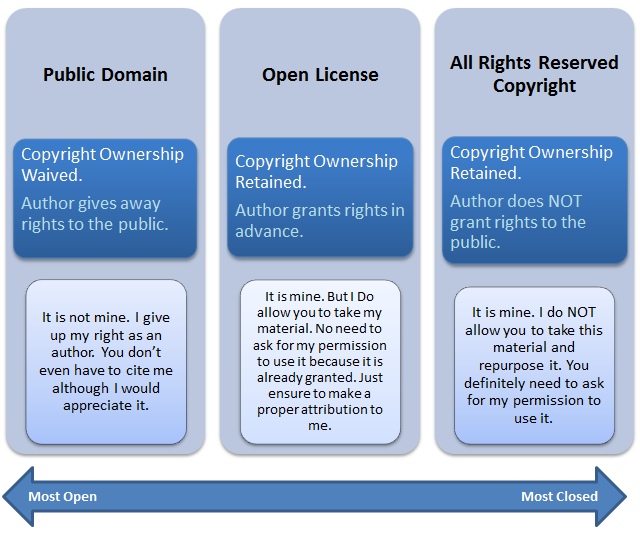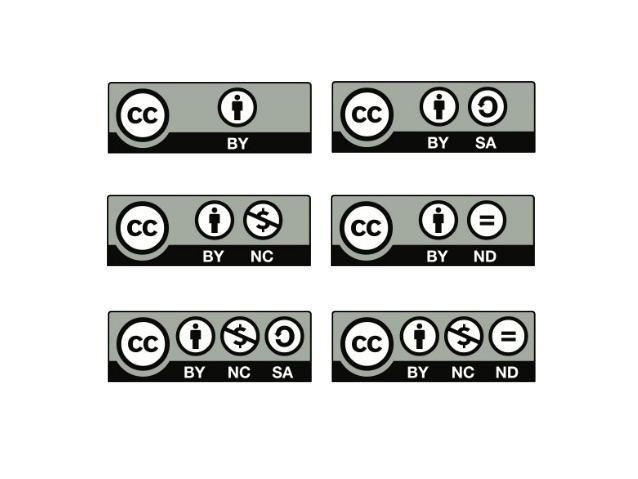1 Copyright, Public Domain, and Creative Commons
Before proceeding, let’s do a quick run-down on Copyright. Copyright is the basis upon which Creative Commons Licenses (the most common type of open licensing for OER) are built. It is important to note that copyright exceptions, such as Fair Use, are not limited by Creative Commons Licenses, so it’s good to have a basic understanding of copyright. Additionally, works in the Public Domain are considered to be OER. So let’s get started.
Copyright Basics
- Copyright does not protect facts or ideas themselves, only the expression of those facts or ideas. That may sound simple, but unfortunately it isn’t. The difference between an idea and the expression of that idea can be tricky, but it’s also extremely important to understand. While copyright law gives creators control over the expression of an idea, it doesn’t allow the copyright holder to own or exclusively control the idea itself.
- As a general rule, copyright is automatic the moment a work is fixed in a tangible medium. For example, you have a copyright as soon as you type the first stanza of your poem or record a song in most countries. Registering your copyright with a local copyright authority allows you to officially record your authorship, and in some countries this may be necessary to enforce your rights or might provide you with certain other advantages. But generally speaking, you don’t have to register your work to become a copyright holder.
- Copyright protection lasts a long time, often many decades after the creator dies.
What’s Copyrightable?
- Literary and artistic works
- Translations, adaptations, arrangements of music, and alterations of literary and artistic works
- Collections of literary and artistic works
Additionally, depending on the country, original works of authorship may also include, among others:
- Applied art and industrial designs and models
- Computer software
“Copyright Basics” and “What’s Copyrightable” adapted from Creative Commons Certificate for Educators and Librarians by Creative Commons, CC BY.
The Public Domain
Despite the expansive reach of copyright, there’s still a rich (and growing) public domain full of works that are free from copyright. Works enter the public domain in one of four ways:
- The copyright expires. While copyright terms are longer than ever before, they’re not infinite. In most countries, the term of an individual’s copyright expires 50 years after their death. In some countries, the term is longer and can be up to 100 years after the author dies.
- The copyright holder failed to comply with formalities to acquire or maintain their copyright. Today in most countries, there are no formal requirements to acquire or renew copyright protection over a work. This wasn’t always the case, however, and many works have entered the public domain over the years because a creator failed to adhere to formalities.
- The work was never entitled to copyright protection. Copyright covers vast amounts of content created by authors, but certain categories of works fall outside the scope of copyright. For example, works that are purely functional aren’t copyrightable, such as the design of a screw. The Berne Convention identifies additional categories, such as official texts of a legislative, administrative, and legal nature. Further, in some countries, works created by government employees are excluded from copyright protection and aren’t eligible for copyright. Facts and ideas are never copyrightable.
- The creator dedicates the work to the public domain before copyright has expired. In most parts of the world, creators can decide to forego the protections of copyright and dedicate their work to the public domain. Creative Commons has a legal tool called CC0 (“CC Zero”) Public Domain Dedication that helps authors put their works into the worldwide public domain to the greatest extent possible.
“Public Domain” adapted from Creative Commons Certificate for Educators and Librarians by Creative Commons, CC BY.

Creative Commons Licenses
Copyright operates by default under an “all rights reserved” approach. Creative Commons licenses function within copyright law, but they utilize a “some rights reserved” approach. While there are several different CC license options, all of them grant the public permission to use the works under certain standardized conditions. The licenses grant those permissions for as long as the underlying copyright lasts or until you violate the license terms. This is what we mean when we say CC licenses work on top of copyright, not instead of copyright.
The licenses were designed to be a free, voluntary solution for creators who want to grant the public up-front permissions to use their works. Although they are legally enforceable tools, they were designed in a way that was intended to make them accessible to non-lawyers.
All Creative Commons licenses ensure that creators retain their copyright and get credit for their work, while permitting others to copy and distribute it. Although the tools are designed to be as easy to use as possible, there are still some things to learn in order to fully understand their mechanics.
“Creative Commons License” adapted from Creative Commons Certificate for Educators and Librarians by Creative Commons, CC BY.

Exercise below is adapted from Knowledge Check from UH OER Training by William Meinke, CC BY 4.0.

